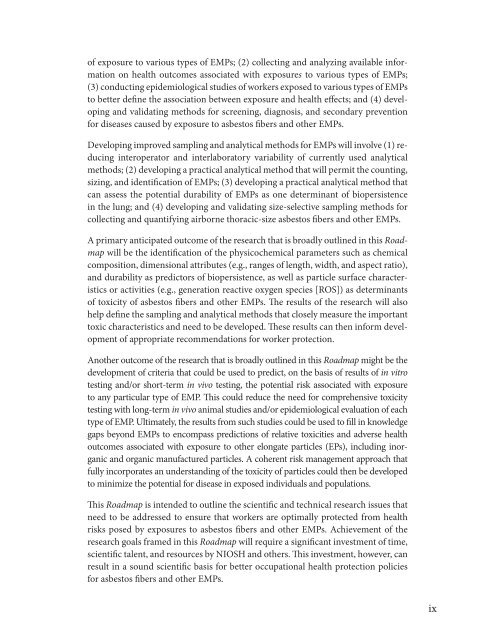Asbestos Fibers and Other Elongate Mineral Particles: State of the ...
Asbestos Fibers and Other Elongate Mineral Particles: State of the ...
Asbestos Fibers and Other Elongate Mineral Particles: State of the ...
- No tags were found...
You also want an ePaper? Increase the reach of your titles
YUMPU automatically turns print PDFs into web optimized ePapers that Google loves.
<strong>of</strong> exposure to various types <strong>of</strong> EMPs; (2) collecting <strong>and</strong> analyzing available information<br />
on health outcomes associated with exposures to various types <strong>of</strong> EMPs;<br />
(3) conducting epidemiological studies <strong>of</strong> workers exposed to various types <strong>of</strong> EMPs<br />
to better define <strong>the</strong> association between exposure <strong>and</strong> health effects; <strong>and</strong> (4) developing<br />
<strong>and</strong> validating methods for screening, diagnosis, <strong>and</strong> secondary prevention<br />
for diseases caused by exposure to asbestos fibers <strong>and</strong> o<strong>the</strong>r EMPs.<br />
Developing improved sampling <strong>and</strong> analytical methods for EMPs will involve (1) reducing<br />
interoperator <strong>and</strong> interlaboratory variability <strong>of</strong> currently used analytical<br />
methods; (2) developing a practical analytical method that will permit <strong>the</strong> counting,<br />
sizing, <strong>and</strong> identification <strong>of</strong> EMPs; (3) developing a practical analytical method that<br />
can assess <strong>the</strong> potential durability <strong>of</strong> EMPs as one determinant <strong>of</strong> biopersistence<br />
in <strong>the</strong> lung; <strong>and</strong> (4) developing <strong>and</strong> validating size-selective sampling methods for<br />
collecting <strong>and</strong> quantifying airborne thoracic-size asbestos fibers <strong>and</strong> o<strong>the</strong>r EMPs.<br />
A primary anticipated outcome <strong>of</strong> <strong>the</strong> research that is broadly outlined in this Roadmap<br />
will be <strong>the</strong> identification <strong>of</strong> <strong>the</strong> physicochemical parameters such as chemical<br />
composition, dimensional attributes (e.g., ranges <strong>of</strong> length, width, <strong>and</strong> aspect ratio),<br />
<strong>and</strong> durability as predictors <strong>of</strong> biopersistence, as well as particle surface characteristics<br />
or activities (e.g., generation reactive oxygen species [ROS]) as determinants<br />
<strong>of</strong> toxicity <strong>of</strong> asbestos fibers <strong>and</strong> o<strong>the</strong>r EMPs. The results <strong>of</strong> <strong>the</strong> research will also<br />
help define <strong>the</strong> sampling <strong>and</strong> analytical methods that closely measure <strong>the</strong> important<br />
toxic characteristics <strong>and</strong> need to be developed. These results can <strong>the</strong>n inform development<br />
<strong>of</strong> appropriate recommendations for worker protection.<br />
Ano<strong>the</strong>r outcome <strong>of</strong> <strong>the</strong> research that is broadly outlined in this Roadmap might be <strong>the</strong><br />
development <strong>of</strong> criteria that could be used to predict, on <strong>the</strong> basis <strong>of</strong> results <strong>of</strong> in vitro<br />
testing <strong>and</strong>/or short-term in vivo testing, <strong>the</strong> potential risk associated with exposure<br />
to any particular type <strong>of</strong> EMP. This could reduce <strong>the</strong> need for comprehensive toxicity<br />
testing with long-term in vivo animal studies <strong>and</strong>/or epidemiological evaluation <strong>of</strong> each<br />
type <strong>of</strong> EMP. Ultimately, <strong>the</strong> results from such studies could be used to fill in knowledge<br />
gaps beyond EMPs to encompass predictions <strong>of</strong> relative toxicities <strong>and</strong> adverse health<br />
outcomes associated with exposure to o<strong>the</strong>r elongate particles (EPs), including inorganic<br />
<strong>and</strong> organic manufactured particles. A coherent risk management approach that<br />
fully incorporates an underst<strong>and</strong>ing <strong>of</strong> <strong>the</strong> toxicity <strong>of</strong> particles could <strong>the</strong>n be developed<br />
to minimize <strong>the</strong> potential for disease in exposed individuals <strong>and</strong> populations.<br />
This Roadmap is intended to outline <strong>the</strong> scientific <strong>and</strong> technical research issues that<br />
need to be addressed to ensure that workers are optimally protected from health<br />
risks posed by exposures to asbestos fibers <strong>and</strong> o<strong>the</strong>r EMPs. Achievement <strong>of</strong> <strong>the</strong><br />
research goals framed in this Roadmap will require a significant investment <strong>of</strong> time,<br />
scientific talent, <strong>and</strong> resources by NIOSH <strong>and</strong> o<strong>the</strong>rs. This investment, however, can<br />
result in a sound scientific basis for better occupational health protection policies<br />
for asbestos fibers <strong>and</strong> o<strong>the</strong>r EMPs.<br />
ix

















